Our Vision
The Evolution of Targeted Currencies and an Introduction to OS-Earth
The following text has been extracted from a presentation, and provides an overview of evolved ideas regarding incentives and how currencies create markets.
This page also introduces OS-Earth, our vision for a platform to support the efficient and sustainable use of resources within and between communities.
Understanding Currencies
Currency and currents come from the same root, the Latin verb Correre, meaning “to run.” They are about movement and flow. When we speak of currencies, we mean “the tools for catalyzing currents.”
Currency should NOT be equated with money. Monetary currencies are a small part of a much larger framework.
Flows of trust, reputation, knowledge, information, value, goods, services, resources, gifts, admiration, and the experience of acceptance or belonging are just some of the kinds of things that you can activate with currencies.
The Effect of a Unifying Model
At one time, people explained disease as the result of “the evil eye” or curses. Rules for the safe handling of food were elaborate social/moral/spiritual traditions such as the Laws of Kashrut (Kosher practices). Plagues were blamed on divine punishment.
Germ Theory provided a single model to understand the cause and address the prevention and treatment of all of these issues. Numerous things which were previously thought to be unrelated and disconnected suddenly had a new connection.
Instead of trying to please gods, cast out demons, blame the weather, remove curses, identify and eliminate witches, follow elaborate rules for food combination and preparation, etc… the focus shifted to managing hygiene and contamination.
What does this have to do with currencies?
We say that currencies, are in fact, a unifying model.
Question: What do these things have in common?
- “Buy 9 get 10th free” cards
- Grades in School
- Congressional Medals of Honor
- Postage Stamps
- “Four Star” Hotels
- Academy Awards
- Movie Tickets
- Frequent Flier Miles
- Olympic Gold Medals
- Designer Labels
- Golf Handicaps
- USDA “Grade A”
Answer: They are all fundamentally the SAME THING – currencies targeted to a specific purpose.
These all alter flows within the communities that interact with them. For instance, consumers are willing to pay more for products with an Organic Certification or Designer Label. Farmers alter their practices to meet the requirements to obtain Organic Certification.
Example from a familiar currency model:
Currencies Integrated into University Education
Grades (A-, B+, C…) are a performance metric currency designed to measure the students performance as assessed by the teacher
Credits (5 credit hours of Math) are a unit of account currency which allow the University to tally the classes chosen by students to ensure they’ve met their curriculum requirements
Degrees (B.S., M.B.A., Ph.D.) are a token of status currency intended to demonstrate that somebody has achieved a specific educational status.
All three are used together to establish your academic reputation and shape the flow of participation and engagement of the students. They are examples of non-monetary currencies that we are all familiar with using.
- Economics
- Complexity Theory
- Community Building
- Sociology
- Psychology
- Systems Theory
- Computer Science
- Biology / Environmental Science
We’ve been identifying the dynamics of currencies and building the tools to implement them for diverse applications and communities.
Essential Components to Build a Market
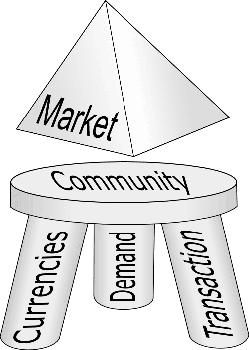
This graphic illustrates the components necessary to creating a market
Currencies - To track and measure value
Demand - A problem being solved or need being met
Transaction - Means of interacting and exchanging
What connects the three ‘legs’ of the stool is the community. These three ‘legs’ can be identified within an already existing community, or the community can be added at the end.
For example, Ebay did not have a community of people to begin with. It had a method to support transactions, currencies to do so, and it met a demand. The community arose later, through their marketing and the continued use of their system to support the transaction of goods.
How Currencies Create Markets
Markets are an emergent phenomenon which have the chance to spring to life when the requisite components are in place.
Some examples of the markets that currencies have enabled:
Shares of Corporate Stock –> The Stock Market (DJI became traded too)
College Degrees (to certify knowledge) –> Colleges & Universities
Academic Grades –> Tutors (why else would you pay a university for a class AND hire a tutor to help you in the subject)
Frequent Flier Miles –> Partner Programs (AA makes over $1B/yr on sales of FFM’s to partners)
eBay Reputation Ratings –> Trusted Brokers
Postage Stamps –> Philately
Event Tickets –> Scalpers
The advent of Germ Theory didn’t instantly solve everyone’s problems. People had to learn new things; for example, washing their hands instead of making the sign to avert the evil eye.
We have a rich vocabulary in the world of objects but a weaker one in the world of complex systems and processes. Currencies are all about process.
What exactly are the properties of a currency? How do they work? How can they be adjusted to fit the needs of different communities? How do you guide the flows?
Designing the FlowSpace within a Marketplace

Using the metaphor of a landscape is one way of representing how multiple flow systems can occur within the same market. This map depicts two distinct flow systems: water & traffic. Each flow path follows different rules. Just as you can design the traffic and water flows, you can design the properties of a currency to create natural tendencies of flow within a marketplace.
Designing Flows as Circuits
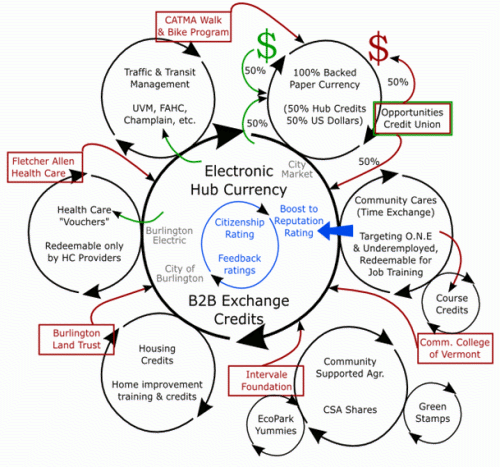
You can design circuits in a more engineered approach, such as an electrical circuit flow, with switches to turn things on and off.
For example, this diagram represents a set of separate currencies for disctinct purposes, with their own flow patterns as designed for the City of Burlington, VT.
The blue paths represent a separate currency for repuation and good citizenship. Green represents issuance events, and red represents redemption or retirement events.
The “Currency Configurator”
We have been building a currency platform that is customizable to create currencies (flow systems) that provide the opportunity for new markets to emerge. The following are screen shots from this platform, code-named the “Configurator.”
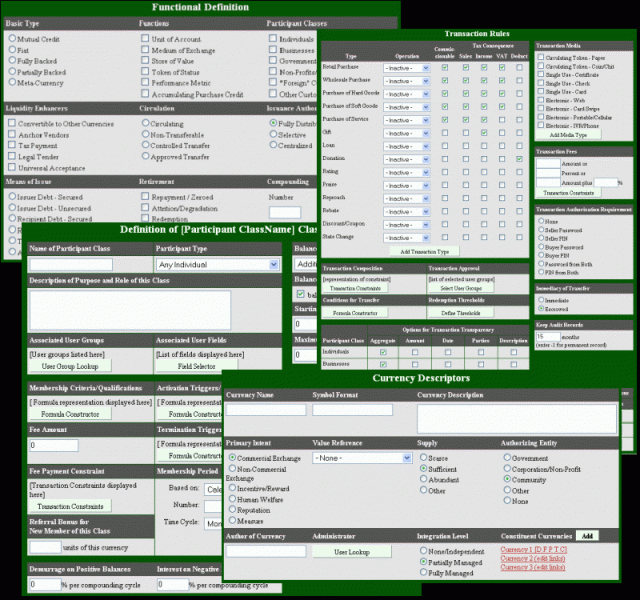
Rules vs. Rewards – Aligning our Incentives
As a society we tend to make rules and laws to try to force others to act the way we think they should. We create rules and then punish the rule breakers. These negative incentives are from a pattern of behavior carried over from a level of consciousness (Spiral Dynamics’ Blue Meme) which focused on rules.
We have an opportunity to redesign our incentives to encourage people to do what they naturally want to - and end up with a better world. We can design currencies to resonate with people in each level of consciousness.
Take a look at this diagram which provides a quick overview of Spiral Dynamics as a point of reference for understanding some of the dimensions of incentives we’re about to introduce.
Layers and Dimensions of Human Incentives
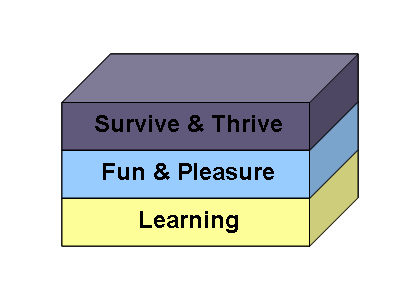
There are multiple layers that are simultaneously present in motivating people and groups. As humans, we are ever driven to learn - about our environment and the rules in which we operate. The experience of Fun & Pleasure encourages continued participation.
We focus on the Survive & Thrive layer for the application of currencies as incentives that appeal to multiple dimensions of human incentives:
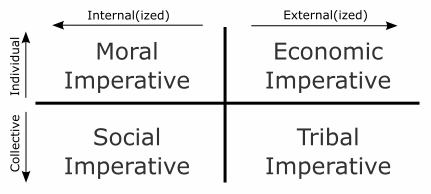
This diagram represents four quadrants of imperatives that are at work at all times. They appeal to people to varying degrees based on their worldview.
Economic Imperative [Individual External] Our motivations that relate to our own physical survival. Here we address our needs for food, clothing, and shelter, sex and safety. This is the area where we are motivated to work for our own economic benefit.
Tribal Imperative [Collective External] This is about the physical needs of our community, and when we put the needs of others ahead of our personal needs. We will sometimes forego personal gain to take care of others because we know that our ‘tribe’ will take care of us when we are in need.
Social Imperative [Collective Internal(ized)] This is internal because it’s about people’s perceptions rather than external, physical needs. This dimension addresses our drive to be accepted and concerned with our status within our community. This is about the judgments people make about the clothes you wear, the car you drive, the language you use, and the way you behave.
Moral Imperative [Individual Internal(ized)] This is about our drive to do what is right. We have a sense of what is right and wrong, good and bad, and it’s important to our perception of ourselves to act in accord with these things.
The next diagram expands the quadrants to include how we interact with people we know and love. We add the Inter-personal layers identified as the Appreciation Imperative (doing good works to experience yourself as being known by others) and the Contribution Imperative (doing something so that you can see the impact out there)
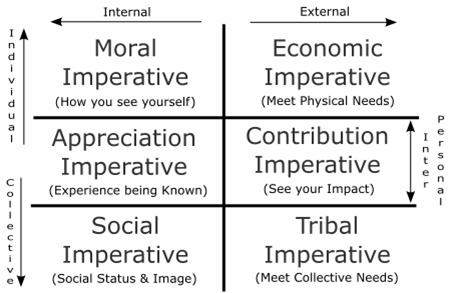
…and their Appeal to Different Levels of Consciousness in Spiral Dynamics
So back to the previous mention of Spiral Dynamics. This next diagram includes the colors used to identify various levels of consciousness in Spiral Dynamics, and associates them with these dimensions of incentives.
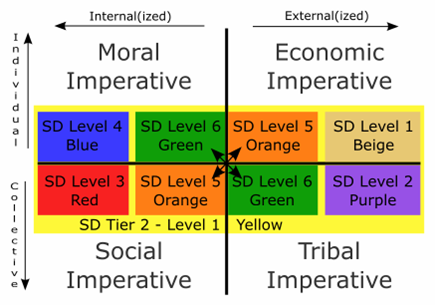
Keep in mind that this is simply a framework we have created to help understand which motivations resonate most strongly with different people and groups, based on the level of consciousness they have acheived.
The first level of consciousness is the Beige Meme, found in the upper right corner. This is about basic human survival where food, warmth, sex and safety have priority.
Next is the Purple Meme, which brought about magical rituals and local customs - providing for collective safety and belonging in the community.
On the bottom left corner is level three, the Red Meme. This level focuses on heirarchies and determining the pecking order by having the strongest survive. The military is a good example of the Red Meme being manifested.
Next is the Blue Meme, where moralistic ideas are institutionalized. This can be observed in standard education, organized religion, and the government. This is the context for much of the debate about abortion, where individuals who believe it to be wrong want to make it illegal for anyone to do it.
We say that the next two levels are seen in the cross dynamics of two dimensions. The first is level 5, the Orange Meme. In this level we see individuals striving to be ‘the best,’ to elevate their “socio-economic” status.
As people expand their perception beyond their own personal achievement, they begin to care more about what is good for the larger whole. The Green Meme is driven by an individual’s moral sense of what’s right and wrong as it relates to the needs of the community. This level of consciousness has manifested human rights movements, environmental activism, Cultural Creatives, and socially responsible enterprise.
The second tier in Spiral Dynamics marks a point in consciousness where the strengths and weaknesses of the previous levels are embraced and transcended. The Yellow Meme recognizes the world as being prone to chaos and change, and allows for flexibility and responsibility in relating to it. We say that targeted currencies reside in this meme, and can be designed to appeal to each level of consciousness.
Resource Sharing for Spaceship Earth
We face many possible futures regarding life on this Spaceship Earth. If we continue on our current path, the future looks fairly ugly. Can we figure out how to harmoniously and effectively share the resources of this planet?
Our vision for making this possible includes generating numerous economies, gift economies, and an otherwise rich ecology of currencies.
Our current monetary system drives greed, ideas of scarcity, and competition that forsakes all others. Corporations are incented to exploit resources for maximum profit. This is akin to the way cancer behaves in the human body. Rougue cells stop cooperating with all other cells, stealing resources for themselves. This eventually leads to the suffering and death of the entire organism.
Discovering the vision for OS-Earth was like having the experience of discovering the cure for cancer, a way to heal the planet and ourselves.
Understanding how to bring this healing to our communities requires understanding the phenomenon of modern communities.
New-Fangled Communities
Our models for relating to community are based on an old notion of community based on proximity. New modes of communicating and acculturating have resulted new types of communities. We interact in a virtual world with people of similar interests. The conversations taking place and connections being made cross many boundaries, both physically, socially, and economically. These communities are more loosely knit, and currencies can help provide the means to weave them more tightly.
We can intentionally design the currencies and methods of transactions to create new connections, strengthen relationships, establish all kinds of new flows of communication. An example of how this works is something we are experienced with, although not necessarily aware of: imbalanced transactions.
In a community of proximity, imbalanced transactions are natural. You can go next door and ask for a cup of sugar. Your neighbor isn’t expecting anything in return - in fact, it would be weird for you to offer $1 in exchange, or to show up the next week with a cup of sugar in return.
It’s different when you buy sugar at the grocery store. You exchange money for the goods, and most of us don’t even notice the person handling the exchange. It’s a balanced, tit-for-tat transaction. I give you something, you give me something in return. Similarly, many online transactions provide little in the way of relationship - Arthur’s done over 50 ebay transactions, but none of them have resulted in a relationship with an individual. In an imbalanced transaction, relationships are created. If you borrow a cup of sugar from your neighbor, she is more likely to trust you enough to ask something in return - although there is no real obligation to do so.
Creating opportunities for more imbalanced and/or gift transactions is one way to weave tighter communities.
OS-Earth - Helping Communities Better Manage their “Island”
OS-Earth is short for “Operating System for Spaceship Earth.” Geeky, yes, but think of the role of the operating system of a computer. It allows numerous applications to share the single resources of the hard drive, processor, memory, monitor and keyboard, all in an ordered, harmonious manner.
We think of communities as “Islands,” each with their own resources, characteristics, and values. OS-Earth provides the infrastructure and tools to facilitate, track and manage interactions using currencies that uniquely embody the values of the community while strengthening relationships, fostering trust, demonstrating reputation and enabling sustainable resource sharing. These tools can be used to help each community manage their island better.
Even Islands are Part of the Same Planet
On the surface, islands appear to be separated from each other, encompassed by the sea. However, these individual islands are in fact part of the same planet and participating in some shared flows (such as earth, air, water, bird migrations, etc.) with each other.
Being autonomous does not mean independence, but rather - interdependence. Just as every island is part of the same planet, each community is part of a larger resource sharing framework.
Within the OS-Earth framework, Communities can determine various forms of participation and levels of integration within the system, allowing for the trusted sharing of resources across communities. And individuals within multiple communities can also bridge connections for people between islands.
Technical Infrastructure for OS-Earth
These are the highlights:
All development will be done as Open Source and shared back to the community.
Uses Currency Configurator with Transaction Engine (and Isometric Rating Tables)
Triple-Entry Accounting (digitally signed receipts as master record)
Also using Congo-DB – Distributed Data Engine with XDI compatibility
